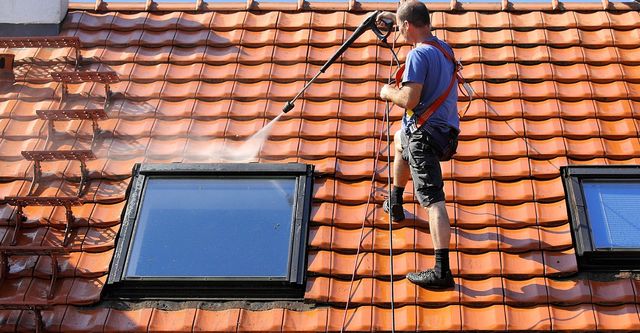Keeping your roof in good shape can save you from an expensive headache down the road. Most homeowners should have their roofs cleaned once per year, but there are some caveats. Below, you’ll find all the information you need about cleaning your roof, including the best frequency depending on where you live and how to do it yourself if you’re feeling adventurous.

Table of Contents
Why Your Roof Needs to Be Cleaned
Cleaning your roof is mostly a matter of curb appeal, although keeping your roof clean is also important for maximizing its longevity.
Aesthetics
A dirty roof is impossible to hide and gives off the impression that your home is not well cared for. This is especially problematic for homes with light-colored shingles since even relatively small amounts of dirt and grime have enough contrast to stand out. You can get away with cleaning your roof less frequently if you have darker shingles, although you should still inspect it regularly to avoid structural problems.
To Avoid Wear and Tear
Any debris that gets lodged in your roof can cause damage if you don’t remove it, so cleaning away branches and leaves is important for your roof’s health. Anything stuck in your roof can loosen shingles with time, and one strong wind storm is all it takes to do serious damage.
How Often Should You Clean Your Roof?
Most experts recommend having your roof cleaned by a professional at least once per year. However, if your property is heavily wooded or if you live near saltwater you might want to up the frequency slightly. You should also consider more frequent cleanings if you live somewhere with a lot of rainfall or high humidity since moss and mold are common in such environments and are more difficult to remove once they become entrenched.
You might be able to get away with less frequent cleanings if your roof is new. Damage accumulates over time, and new roofs are more resilient than old ones. Still, if you want to keep your roof in the best shape possible, you shouldn’t wait longer than two years between cleanings, even if your roof was installed recently.
Can You Clean Your Roof Yourself?
You can, but it’s not the best idea. Professional roof cleaning services know what to look for and won’t miss problem areas that could lead to expensive repairs in the future. They’ll also have all the equipment needed to clean your roof safely and effectively. Purchasing the necessary equipment yourself becomes expensive quickly, closing the price gap between cleaning your roof yourself and hiring a professional.
More importantly, even if you have the best home warranty options for your roof, your plan might not include accidental damage you cause attempting to clean it yourself. Some home warranty plans have stipulations that specifically require frequent professional cleanings to meet the terms of the agreement. Make sure to check your warranty before you start cleaning to ensure your roof will still be covered.
DIY Roof Cleaning Tips
If you decide to attempt to clean your roof yourself, you should keep a few things in mind.
Use the Right Equipment
At the bare minimum, you’ll need the following equipment to clean your roof:
- A safety harness
- Hose
- Spray Nozzle
- Lye (and related safety gear)
- Roof cleaner
- A water pump
You’ll only need lye if you’re battling mold and algae since it is better at permanently removing colonies and dissuading them from reforming. Unfortunately, lye is dangerous to handle directly, so you’ll need protective equipment like gloves and a face shield to use it.
Pick the Right Day
Most people wait until it’s going to be nice and sunny to clean their roof, but it’s actually better to wait for a cool, cloudy day to prevent the roof cleaner from drying too quickly. The chemicals in most roof cleaners take time to work, and direct sunlight causes them to dry up before they have a chance to work.
Skip the Leaf Blower
Many people use a leaf blower to remove branches and leaves from their roof, but it’s not a great idea. While it will definitely remove dirt and debris from hard-to-reach places, it might also take off a shingle or two if your leaf blower is powerful enough. The safer option is to use a broom; it will take a bit longer but is less likely to damage your shingles.






